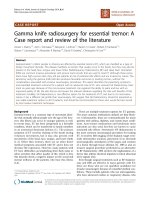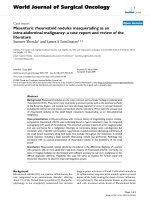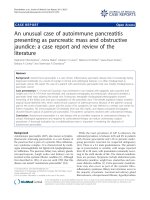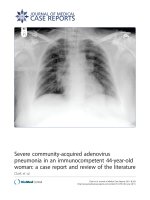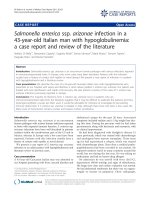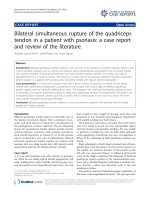Báo cáo y học: " Oral melanoacanthoma: a case report and review of the literature" ppsx
Bạn đang xem bản rút gọn của tài liệu. Xem và tải ngay bản đầy đủ của tài liệu tại đây (395.89 KB, 4 trang )
BioMed Central
Page 1 of 4
(page number not for citation purposes)
Journal of Medical Case Reports
Open Access
Case report
Oral melanoacanthoma: a case report and review of the literature
Vidya Lakshminarayanan and Kannan Ranganathan*
Address: Department of Oral and Maxillofacial Pathology, Ragas Dental College and Hospital, East Coast Road, Chennai, Tamilnadu 600119,
India
Email: Vidya Lakshminarayanan - ; Kannan Ranganathan* -
* Corresponding author
Abstract
Introduction: Oral melanoacanthoma is a rare, benign pigmented lesion characterized clinically
by the sudden appearance and rapid growth of a macular brown-black lesion and histologically by
acanthosis of the superficial epithelium and proliferation of dendritic melanocytes.
Case presentation: We present a case report of oral melanoacanthoma in a 24-year-old Asian
Indian man. He presented with an intra-oral brown macular lesion on the left buccal mucosa with
a duration of one and a half months. Microscopic examination revealed acanthosis of stratified
squamous surface epithelium and dendritic melanocytes diffusely distributed in the epithelium; the
Masson-Fontana silver impregnation technique was used to demonstrate the dendritic
melanocytes. Based on the history, clinical features and histological presentation, the lesion was
diagnosed as melanoacanthoma.
Conclusion: This is the first reported instance of oral melanoacanthoma in the Indian sub-
continent. This report details the course of the lesion from diagnosis to its resolution.
Melanoacanthoma must be differentiated from other intra-oral pigmented lesions and biopsy may
be required to rule out melanoma.
Introduction
Melanoacanthoma of the oral mucosa is a rare condition
indicative of a reactive process [1]. Oral melanoacan-
thoma was first reported in 1978 [2] and to the best of our
knowledge, only 50 cases of melanoacanthoma have been
reported in the literature to date (Table 1) [2-14]. The clin-
ical presentation is a brown to brown-black macular
lesion, predominantly solitary, encountered in the
younger age group with a distinct female predilection
[3,12]. The most common site affected is the buccal
mucosa. Melanoacanthoma has been reported in labial
mucosa, palate, gingiva, alveolar mucosa and oropharynx
(Table 1). The typical histological picture of melanoacan-
thoma is the proliferation of dendritic melanocytes
throughout the epithelium. The epithelium exhibits acan-
thosis and spongiosis. A chronic inflammatory cell infil-
trate with eosinophils may be noted. The lesion is benign
and may regress following an incisional biopsy [1].
Case presentation
A 24-year-old graduate dental student presented with a
complaint of intra-oral pigmentation of the left buccal
mucosa with duration of one and a half months. The
patient had initially noted a small round area of pigmen-
tation of about 5 mm in size which, to his concern, had
rapidly increased to the present size (Figure 1). He did not
report any discomfort associated with the lesion, except
for an altered surface texture. Personal history revealed
Published: 13 January 2009
Journal of Medical Case Reports 2009, 3:11 doi:10.1186/1752-1947-3-11
Received: 1 February 2008
Accepted: 13 January 2009
This article is available from: />© 2009 Lakshminarayanan and Ranganathan; licensee BioMed Central Ltd.
This is an Open Access article distributed under the terms of the Creative Commons Attribution License ( />),
which permits unrestricted use, distribution, and reproduction in any medium, provided the original work is properly cited.
Journal of Medical Case Reports 2009, 3:11 />Page 2 of 4
(page number not for citation purposes)
that the patient had infrequently (once a day) smoked fil-
tered cigarettes over the previous 4 years. Intra-oral exam-
ination revealed carious 28, multiple teeth with glass
ionomer cement (GIC) class V restoration (36, 37, 38, 46,
and 47) and a brownish-black macular lesion in the left
buccal mucosa. On further enquiry, the patient revealed
that he had undergone multiple GIC restorations 3
months previously, during which procedure he had sus-
tained a mild bur injury in the left buccal mucosa, which
healed uneventfully.
The brownish-black macular lesion on the left buccal
mucosa was well demarcated from the surrounding
mucosa with regular, well-defined borders. The lesion
extended anteriorly from the region of the mandibular
first molar (36) to the mandibular left canine region. It
measured 25 mm antero-posteriorly and had a maximum
width of 16 mm supero-inferiorly. The lesion was not ten-
der, did not blanch under pressure and was not fixed to
the underlying mucosa.
Diagnosis
Following incisional biopsy, the specimen was fixed in
10% neutral buffered formalin, routinely processed and
paraffin embedded. Histopathological examination of the
lesion revealed a stratified squamous surface epithelium
exhibiting acanthosis, spongiosis, melanin pigmentation,
inflammatory cell exocytosis and numerous dendritic
melanocytes distributed diffusely in the suprabasal and
spinous layers. A chronic inflammatory cell infiltrate was
present in the subjacent connective tissue. The dendritic
melanocytes were also demonstrated by Masson-Fontana
silver impregnation stain (Figure 2). Based on the history,
clinical features and histological presentation, the lesion
was diagnosed as melanoacanthoma.
Management
The lesion characteristically appeared to regress following
the biopsy procedure. A regular follow-up of the patient
Table 1: List of reports of oral melanoacanthoma [2-14]
S. no. Author Year No. of patients Site
1 Tomich [11]* 1978 1 Buccal mucosa
2 Matsuoka et al. [2]* 1979 1 Labial mucosa
3 Schneider et al. [2] 1981 1 Buccal mucosa
4 Wright et al. [2]* 1983 2 Buccal mucosa
5 Goode et al. [4] 1983 10 Buccal, labial, palatal, alveolar mucosa and gingiva
6 Frey et al. [5] 1984 1 Buccal mucosa
7 Sexton and Maize [6] 1987 3 Labial mucosa
8 Wright [2]* 1988 1 Buccal mucosa
9 Whitt et al. [3]* 1988 1 Buccal mucosa
10 Horlick et al. [3]* 1988 2 Buccal mucosa
11 Zemtsov and Bergfeld [7] 1989 1 Multiple
12 Heine et al. [2]* 1996 1 Buccal mucosa – bilateral
13 Chandler et al. [8] 1997 1 Palate
14 Flaitz [9] 2000 1 Gingiva
15 Fatazedah and Sirois [10] 2002 1 Multiple sites
16 Fornatora et al. [3]* 2003 10 Buccal (including bilateral), gingival, labial and palatal mucosa; retromolar pad, floor of
the mouth
17 Buchner et al. [11] 2004 7 Buccal, labial and lingual mucosa
18 Kauzman et al. [12] 2004 1 Buccal mucosa
19 Andrews and Trask [13] 2005 1 Buccal mucosa
20 Carlos-Bregni et al. [14] 2007 4 Buccal mucosa, gingiva, palate
*Cross-referenced from the literature.
Brownish-black macular lesion on left buccal mucosa adja-cent to molar teeth with Class V glass ionomer cement res-torations (arrows)Figure 1
Brownish-black macular lesion on left buccal mucosa
adjacent to molar teeth with Class V glass ionomer
cement restorations (arrows).
Journal of Medical Case Reports 2009, 3:11 />Page 3 of 4
(page number not for citation purposes)
was carried out to observe the progress of the lesion (Fig-
ure 3).
Discussion
The term melanoacanthoma refers to a lesion exhibiting a
proliferation of dendritic melanocytes throughout the sur-
face epithelium. Cutaneous melanoacanthoma is also
known as pigmented seborrheic keratosis [15].
Oral melanoacanthoma is a benign, reactive process and
is unrelated to cutaneous melanoacanthoma. The
reported age of presentation ranges from 9 to 77 years,
with a mean age of 29 years [3,4,12]. The lesion is most
predominantly observed among black patients, though
occurrences have been observed among Caucasians, His-
panics and Asians [1,4,12-14]. Oral melanoacanthomas
show a female predilection, with a male to female ratio of
2:1 [1,2,14]. The etiology has been largely attributed to
local irritation or even mild trauma [3,14]. The intra-oral
site most commonly affected is the buccal mucosa but
involvement of other sites such as the mucosa of the lip,
palate, gingiva and alveolar mucosa has also been
reported (Table 1). Clinically, the lesion is a flat or slightly
raised black or brown macule and may rapidly increase in
size, ranging from a few millimeters to several centimeters
[1,12,13]. The lesions are usually solitary and well circum-
scribed though a few authors have reported bilateral or
multiple (Table 1) melanoacanthomas. Oral melanoacan-
thomas are usually asymptomatic and are not neoplastic.
The other lesions to be considered in the differential diag-
nosis are smoker's melanosis, drug induced pigmentation,
Addison's disease, melanotic macule, pigmented nevi –
junctional, intramucosal, compound, Spitz nevus, postin-
flammatory melanosis and oral melanoma. A biopsy is
mandatory to rule out melanoma and to alleviate patient
apprehension. Histologically, melanocytes which are usu-
ally restricted to the basal layer are found distributed
throughout the epithelium. These melanocytes exhibit
prominent dendritic processes and are immunoreactive
for S-100, Melan-A/Mart-1, HMB-45 and Tyrosinase [14].
Other dendritic cells in the oral mucosa are the Langer-
hans' cells which are antigen presenting cells of the
immune system, usually distributed in the superficial epi-
thelium and are demonstrated on immunohistochemistry
Hematoxylin and eosin stained sections (A, B and C) revealed stratified squamous non-keratinized epithelium exhibiting acan-thosis and numerous dendritic melanocytes throughout the entire thickness of the epithelium; Masson-Fontana (M-F) special stain reveals numerous melanocytesFigure 2
Hematoxylin and eosin stained sections (A, B and C) revealed stratified squamous non-keratinized epithelium
exhibiting acanthosis and numerous dendritic melanocytes throughout the entire thickness of the epithelium;
Masson-Fontana (M-F) special stain reveals numerous melanocytes.
Follow-up of lesion after 1 week (A), after 2 weeks (B) and complete resolution after 2 months (C)Figure 3
Follow-up of lesion after 1 week (A), after 2 weeks (B) and complete resolution after 2 months (C).
Publish with BioMed Central and every
scientist can read your work free of charge
"BioMed Central will be the most significant development for
disseminating the results of biomedical research in our lifetime."
Sir Paul Nurse, Cancer Research UK
Your research papers will be:
available free of charge to the entire biomedical community
peer reviewed and published immediately upon acceptance
cited in PubMed and archived on PubMed Central
yours — you keep the copyright
Submit your manuscript here:
/>BioMedcentral
Journal of Medical Case Reports 2009, 3:11 />Page 4 of 4
(page number not for citation purposes)
by S-100 or CD1a. The adjacent connective tissue exhibits
chronic inflammatory cell infiltrate. The presence of eosi-
nophils among the inflammatory cells is not a universal
feature and may not be essential for the diagnosis of oral
melanoacanthoma. Once diagnosis is established, no fur-
ther treatment is required, with some cases exhibiting
spontaneous regression after biopsy [1]. It has been sug-
gested that this entity be renamed melanoacanthosis or
oral melanotic macule – reactive type, since the term
melanoacanthoma is suggestive of a neoplastic process
[11].
In our patient, the etiology of the lesion may be attributed
to the incident of trauma during the restorative procedure.
It may be safely assumed that GIC did not contribute to
the cause of the lesion since the patient has multiple res-
torations with the same material and the adjacent sites did
not exhibit any lesion.
Conclusion
To the best of our knowledge, this is the first case of oral
melanoacanthoma in the Indian subcontinent and the
second case of melanoacanthoma reported in an Asian
Indian. In the present instance, a biopsy was performed to
alleviate the patient's anxiety and as reported, the lesion
regressed following biopsy. Thus, melanoacanthoma
must be considered in the differential diagnosis of rapidly
progressing pigmented lesions of the oral cavity and
requires a histopathological diagnosis to rule out
melanoma.
Consent
Written informed consent was obtained from the patient
for publication of this case report and any accompanying
images. A copy of the written consent is available for
review by the Editor-in-Chief of this journal.
Competing interests
The authors declare that they have no competing interests.
Authors' contributions
Both authors have made substantial contribution with
individual input as follows:
KR was responsible for identification, diagnosis of the
case, drafting of manuscript and final correction of the
version to be published. VL was involved in follow up of
the patient, literature review and revising and submission
of manuscript. The final version of the manuscript was
approved by both authors
Acknowledgements
We thank our Principal, Dr. S. Ramachandran, for encouraging and facilitat-
ing the publication of this case report and Dr. Sai Prasanth, for having
referred the case.
References
1. Neville B, Damm DD, Allen CM, Bouquot J: Oral and Maxillofacial
Pathology Philadelphia, PA: WB Saunders Company; 2004.
2. Schneider LC, Mesa ML, Haber SM: Melanoacanthoma of the oral
mucosa. Oral Surg Oral Med Oral Pathol 1981, 52:284-287.
3. Fornatora ML, Reich RF, Haber S, Solomon F, Freedman PD: Oral
melanoacanthoma – a report of 10 cases, review of the liter-
ature, and immunohistochemical analysis for HMB-45 reac-
tivity. Am J Dermatopathol 2003, 25:12-15.
4. Goode RK, Crawford BE, Callihan MD, Neville BW: Oral melanoa-
canthoma: review of the literature and report of ten cases.
Oral Surg Oral Med Oral Pathol 1983, 56:622-628.
5. Frey VM, Lambert W, Seldin RD, Schneider LC, Mesa ML: Intraoral
melanoacanthoma. J Surg Oncol 1984, 27:93-96.
6. Sexton FM, Maize JC: Melanotic macules and melanoacantho-
mas of the lip: a comparative study with census of the basal
melanocytic population. Am J Dermatol 1987, 9:438-444.
7. Zemtsov A, Bergfeld WF: Oral melanoacanthoma with promi-
nent spongiotic intraepithelial vesicles. J Cutan Pathol 1989,
16:365-369.
8. Chandler CK, Chaudhry Z, Kumar N, Barrett AW, Porter S: A rare
cause of oral hyperpigmentation. Oral Surg Oral Med Oral Pathol
Oral Radiol Endod 1997, 84:492-494.
9. Flaitz CM: Oral melanoacanthoma of the attached gingiva. Am
J Dent 2000, 13:162.
10. Fatahzadeh M, Sirois MA: Multiple intraoral melanoacantho-
mas: a case report with unusual findings. Oral Surg Oral Med
Oral Pathol Radiol Endod 2002, 94:54-56.
11. Buchner A, Merrell PW, Carpenter WM: Relative frequency of
solitary melanocytic lesions of the oral mucosa. J Oral Pathol
Med 2004, 33:550-557.
12. Kauzman A, Pavone M, Blanas N, Bradley G: Pigmented lesions of
the oral cavity: review, differential diagnosis and case pres-
entations. J Can Dent Assoc 2004, 70:682-683.
13. Andrews BT, Trask DK: Oral melanoacanthoma: a case report,
a review of the literature, and a new treatment option. Ann
Otol Rhinol Laryngol 2005, 114:677-680.
14. Carlos-Bregni R, Contreras E, Netto AC, Mosqueda-Taylor A, Vargas
PA, Jorge J, León JE, de Almeida OP: Oral melanoacanthoma and
oral melanotic macule: a report of 8 cases, review of the lit-
erature, and immunohistochemical analysis. Med Oral Patol
Oral Cir Bucal 2007, 12:E374-E379.
15. Freeburg IM, Eisen AZ, Wolff K, Austen KF, Goldsmith LA, Katz SI,
Fitzpatrick TB: Fitzpatrick's Dermatology in General Medicine New York:
McGraw Hill; 1999.
